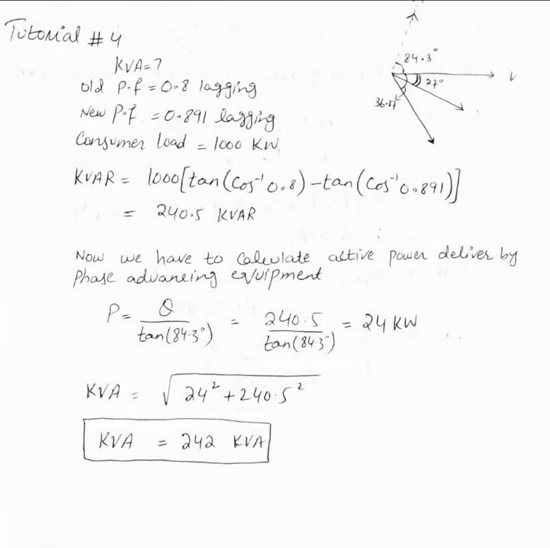TUTORIAL PROBLEMS 01
1. What should be the kVA rating of a capacitor that would raise
the power factor of load of 100 kW from
0·5 lagging to 0·9 lagging ? [125 kVA]
2. A 3-phase, 50 Hz, 3300 V star connected induction motor develops
250 H.P. (186·5 kW), the power
factor being 0·707 lagging and the efficiency 0·86. Three capacitors in delta
are connected across the
supply terminals and power factor raised to 0·9 lagging. Calculate :
(i) the kVAR rating of the capacitor bank.
(ii) the capacitance of each unit. [(i) 111·8
kVAR (ii) 10·9 µF]
3. A 3-phase, 50 Hz, 3000 V motor develops 600 H.P. (447·6 kW), the power factor being 0·75 lagging and
the efficiency 0·93. A bank of capacitors is connected in delta across the supply terminals and power
factor raised to 0·95 lagging. Each of the capacitance units is built of five similar 600-V capacitors.
Determine the capacitance of each capacitor. [156 µF]
4. A factory takes a load of 800 kW at 0·8 p.f. (lagging) for 3000 hours per annum and buys energy on tariff
of Rs 100 per kVA plus 10 paise per kWh. If the power factor is improved to 0·9 lagging by means of
capacitors costing Rs 60 per kVAR and having a power loss of 100 W per kVA, calculate the annual
saving effected by their use. Allow 10% per annum for interest and depreciation on the capacitors.
[Rs 3972]
5. A station supplies 250 kVA at a lagging power factor of 0·8. A synchronous motor is connected in
parallel with the load. If the combined load is 250 kW with a lagging p.f. of 0.9, determine :
(i) the leading kVAR taken by the motor.
(ii) kVA rating of the motor.
(iii) p.f. at which the motor operates. [(i) 28·9 kVAR (ii) 57·75 kVA (iii) 0·866 lead]
6. A generating station supplies power to the following :
(i) a lighting load of 100 kW;
(ii) an induction motor 800 h.p. (596·8 kW) p.f. 0·8 lagging,
efficiency 92%;
(iii) a rotary converter giving 150 A at 400 V at an efficiency of
0·95.
What must be the power factor of the rotary convertor in order that power
factor of the supply station may
become unity ? [0·128 leading]
7. A 3-phase, 400 V synchronous motor having a power consumption of
50 kW is connected in parallel
with an induction motor which takes 200 kW at a power factor of 0·8 lagging.
(i) Calculate the current drawn from the mains when the power
factor of the synchronous motor is
unity.
|
(ii) At
what power factor should the synchronous motor operate so that the current
drawn from the |
mains
is minimum. ? [(i) 421 A (ii) 0·316
leading]
8. A
factory load consists of the following:
|
(ii) At
what power factor should the synchronous motor operate so that the current
drawn from the
|
mains is minimum. ? [(i) 421 A (ii) 0·316 leading]
TUTORIAL PORBLEMS 02
1. A factory which has a maximum
demand of 175 kW at a power factor of 0·75 lagging is charged at Rs 72
per kVA per annum. If the phase advancing equipment costs Rs 120 per kVAR, find
the most economical
power factor at which the factory should operate. Interest and depreciation
total 10% of the capital
investment on the phase advancing equipment. [0·986
leading]
2. A consumer has a steady load of 500 kW at a power factor of 0·8
lagging. The tariff in force is Rs 60 per
kVA of maximum demand plus 5 paise per kWh. If the power factor is improved to
0·95 lagging by
installing phase advancing equipment, calculate :
(i) The capacity of the phase
advancing equipment.
(ii) The annual saving effected.
The phase advancing equipment costs Rs 100 per kVAR and the annual interest and
depreciation together
amount to 10%. [(i) 210·6 kVAR (ii) Rs. 3,815]
3. A factory has an average demand of 320 kW and an annual load
factor of 50%. The power factor is 0·8
lagging. The traiff is Rs 80 per annum per kVA of maximum demand plus 5 paise
per kWh. If the loss
free capacitors costing Rs 100 per kVAR are to be utilised, find the value of
power factor at which
maximum saving will result. The interest and depreciation together amount to
12%. Also determine the
annual saving effected by improving the power factor to this value. [0·988 lagging ; Rs 3040]
4. What will be the kVA rating of a phase advancing plant if it
improves p.f. from 0·8 lagging to 0·891
lagging ? The consumer load is 1000 kW and the current taken by the phase
advancer leads the supply
voltage at a p.f. of 0·1. [230 kVA]
5. A consumer takes a steady load of 300 kW at a lagging power
factor of 0·7 for 3000 hours a year. The
tariff is Rs 130 per kVA of maximum demand annually and 4 paise per kWh. The
annual cost of phase
advancing plant is Rs 13 per kVAR. Determine the annual saving if the power
factor of the load is
improved ? [Rs 12929·8]
|
TUTORIAL
PROBLEMS 03
|



















